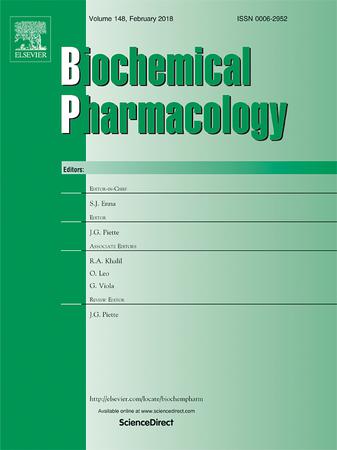Novel aryl hydrocarbon receptor agonists as potential anti-inflammatory therapeutics: Identification and validation through drug repurposing
IF 5.6
2区 医学
Q1 PHARMACOLOGY & PHARMACY
引用次数: 0
Abstract
The aryl hydrocarbon receptor (AhR) was shown to be an important regulator of inflammatory processes at epithelial barriers, and is thus considered a therapeutic target for several chronic inflammatory diseases, such as inflammatory bowel disease. We aimed to identify and validate new AhR agonists that sustainably attenuate intestinal inflammation. Using a high-throughput luciferase reporter gene assay, 90 AhR ligands were identified out of 7448 approved and investigational drugs. Out of these, 15 AhR ligands were selected based on substance class, half maximal effective concentration, known toxicity and pharmacokinetic/pharmacodynamic profiles, and preclinical/clinical evaluation status for other indications. While Febuxostat, Nitazoxanide, Rabeprazole, 2-(1′H-indole-3′-carbonyl)-thiazole-4-carboxylic acid methyl ester, 3-Indolepropionic acid, and Indirubin, were already known as AhR agonists, Nabumetone, Teriflunomide, Timapiprant/OC000459, and Caffeic acid phenylethyl ester have not yet been directly described in this context. Six compounds (Daidzein/Equol, as well as compounds no. 19, 22, 49, and 64, not yet disclosed due to pending patent applications) were newly described as AhR agonists. Hit compounds were studied in silico for their molecular interactions with AhR and in vitro for potential immunotoxicity and their ability to induce interleukin (IL)-10 and/or to suppress IL-1β in murine macrophages without significant cytochrome P450 1A1 induction in Caco-2 cells. Five compounds that met these criteria were functionally tested using organoid-based Transwell®-like models derived from gut biopsies. Five candidates restored the epithelial barrier, as evidenced by increased transepithelial electrical resistance and induction of the tight junction proteins claudin-1/-2 and occludin, while exhibiting anti-inflammatory effects, i.e., decreased expression of toll-like receptor 4. Out of these, one compound was selected for future in vivo preclinical studies.

新型芳烃受体激动剂作为潜在的抗炎治疗药物:通过药物再利用鉴定和验证。
芳烃受体(AhR)被证明是上皮屏障处炎症过程的重要调节因子,因此被认为是几种慢性炎症性疾病(如炎症性肠病)的治疗靶点。我们的目的是鉴定和验证新的AhR激动剂,可持续地减轻肠道炎症。使用高通量荧光素酶报告基因测定,从7448种已批准和正在研究的药物中鉴定出90种AhR配体。其中,根据物质类别、最大有效浓度的一半、已知毒性和药代动力学/药效学特征,以及其他适应症的临床前/临床评估状态,选择了15种AhR配体。虽然非布司他、硝唑尼特、雷巴拉唑、2-(1' h -吲哚-3'-羰基)-噻唑-4-羧酸甲酯、3-吲哚丙酸和靛红已经被称为AhR激动剂,但那布美酮、特立氟米特、Timapiprant/OC000459和咖啡酸苯乙基酯尚未在此背景下被直接描述。六种化合物(大豆苷元/马酚,以及化合物no.;19、22、49和64(由于专利申请尚未公开)被新描述为AhR激动剂。Hit化合物与AhR的分子相互作用和体外潜在的免疫毒性,以及它们在小鼠巨噬细胞中诱导白细胞介素(IL)-10和/或抑制IL-1β的能力,而在Caco-2细胞中没有明显的细胞色素P450 - 1A1诱导。使用基于类器官的Transwell®样模型对符合这些标准的五种化合物进行了功能测试。5种候选药物恢复了上皮屏障,表现为上皮间电阻增加,紧密连接蛋白claudin-1/-2和occludin的诱导,同时表现出抗炎作用,即降低toll样受体4的表达。其中一种化合物被选中用于未来的体内临床前研究。
本文章由计算机程序翻译,如有差异,请以英文原文为准。
求助全文
约1分钟内获得全文
求助全文
来源期刊

Biochemical pharmacology
医学-药学
CiteScore
10.30
自引率
1.70%
发文量
420
审稿时长
17 days
期刊介绍:
Biochemical Pharmacology publishes original research findings, Commentaries and review articles related to the elucidation of cellular and tissue function(s) at the biochemical and molecular levels, the modification of cellular phenotype(s) by genetic, transcriptional/translational or drug/compound-induced modifications, as well as the pharmacodynamics and pharmacokinetics of xenobiotics and drugs, the latter including both small molecules and biologics.
The journal''s target audience includes scientists engaged in the identification and study of the mechanisms of action of xenobiotics, biologics and drugs and in the drug discovery and development process.
All areas of cellular biology and cellular, tissue/organ and whole animal pharmacology fall within the scope of the journal. Drug classes covered include anti-infectives, anti-inflammatory agents, chemotherapeutics, cardiovascular, endocrinological, immunological, metabolic, neurological and psychiatric drugs, as well as research on drug metabolism and kinetics. While medicinal chemistry is a topic of complimentary interest, manuscripts in this area must contain sufficient biological data to characterize pharmacologically the compounds reported. Submissions describing work focused predominately on chemical synthesis and molecular modeling will not be considered for review.
While particular emphasis is placed on reporting the results of molecular and biochemical studies, research involving the use of tissue and animal models of human pathophysiology and toxicology is of interest to the extent that it helps define drug mechanisms of action, safety and efficacy.
 求助内容:
求助内容: 应助结果提醒方式:
应助结果提醒方式:


